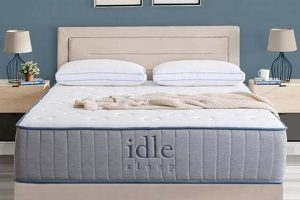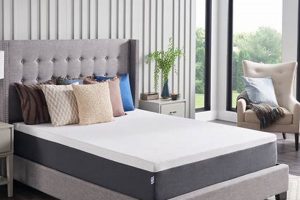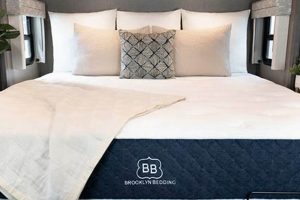The selection of an appropriate sleep surface and supporting structure significantly impacts restorative rest. This combination optimizes comfort and caters to individual preferences regarding sleep position and support. A bed offering tailored articulation provides enhanced support and relaxation.
This type of sleep system offers several advantages. It can alleviate pressure points, improve circulation, and offer customizable positions for reading, watching television, or simply relaxing. Its historical development stems from medical applications aimed at providing comfort and support to patients with mobility limitations, eventually evolving into a consumer product focused on optimizing sleep and lifestyle.
Therefore, the subsequent sections will delve into the factors to consider when evaluating such systems. This includes a detailed examination of mattress material types, base functionalities, and crucial considerations for ensuring compatibility and achieving optimal sleep quality.
Tips for Selecting a Compatible Sleep System
Choosing a compatible mattress and adjustable base requires careful consideration. Attention to detail will ensure optimal performance, longevity, and user satisfaction.
Tip 1: Mattress Material Compatibility: Certain mattress materials function more effectively with adjustable bases. Latex and memory foam mattresses, due to their flexibility, generally conform well to the base’s articulation. Innerspring mattresses with encased coils may also be suitable, but their flexibility should be verified.
Tip 2: Base Motor and Weight Capacity: Evaluate the base’s motor strength and weight capacity. Ensure it can adequately support the combined weight of the mattress and occupants. A robust motor contributes to smooth, reliable adjustments.
Tip 3: Range of Motion: Assess the base’s range of motion. Determine the maximum degree of incline and decline to ensure it meets individual preferences and needs for activities like reading or managing medical conditions.
Tip 4: Mattress Retention System: A mattress retention system, such as a foot bar or corner straps, prevents the mattress from sliding off the base during adjustments. Verify the presence and effectiveness of such a system.
Tip 5: Frame Construction and Stability: Examine the base’s frame construction for sturdiness and stability. A well-constructed frame minimizes noise and ensures long-term durability.
Tip 6: Remote Control and Programmability: Consider the ease of use and features offered by the remote control. Programmable positions allow for quick access to preferred settings.
Tip 7: Trial Period and Warranty: Prioritize purchasing from retailers offering a trial period and a comprehensive warranty. This allows for assessing compatibility and addressing potential defects.
By carefully evaluating these factors, an informed decision can be made, resulting in a sleep system that promotes comfort, support, and overall well-being.
The subsequent section will present a comparative overview of various mattress and base options, offering insights into their specific features and benefits.
1. Material Compatibility
Material compatibility is a central determinant in achieving the performance benefits associated with an adjustable base. The mattress’s composition dictates its ability to conform to the contours created by the base, directly influencing comfort, support, and overall system longevity.
- Conformability and Articulation
Mattresses must possess sufficient flexibility to articulate without damage or distortion. Materials like latex and memory foam exhibit high conformability, allowing them to readily adapt to the base’s angles. Conversely, traditional innerspring mattresses may exhibit limited flexibility, potentially leading to uneven support and reduced lifespan when used with an adjustable base.
- Pressure Distribution and Support
Incompatible materials can compromise pressure distribution. If a mattress cannot conform effectively, concentrated pressure points may arise, diminishing the therapeutic benefits of the adjustable base. Proper material selection ensures even weight distribution, promoting circulation and alleviating discomfort in various inclined positions.
- Durability and Longevity
Excessive stress from forced articulation can accelerate mattress degradation. A rigid mattress on an adjustable base is subject to increased wear and tear, potentially leading to premature sagging, coil damage (in innerspring models), or foam compression. Selecting a compatible material mitigates these risks, extending the lifespan of both the mattress and the base.
- Motion Isolation and Noise Reduction
Material properties also influence motion isolation and noise generation. Flexible materials like memory foam absorb movement effectively, minimizing disturbance to a sleeping partner during base adjustments. Incompatible combinations may produce creaking or squeaking noises, disrupting sleep quality.
Therefore, careful attention to material properties is crucial when selecting the optimal mattress for an adjustable base. Prioritizing materials designed for flexibility and articulation maximizes the potential benefits of this sleep system, ensuring both comfort and durability. The selection process should include consideration of material density, construction methods, and intended use to ensure a harmonious and long-lasting sleep environment.
2. Adjustability Range
Adjustability range, referring to the spectrum of positions an adjustable base can achieve, represents a critical determinant in discerning superior models. The effective operation of the base influences the overall performance of the sleep system, especially when paired with a compatible mattress. A limited range can restrict the system’s capacity to address individual comfort needs, potentially negating the intended benefits. For instance, a base lacking sufficient incline may prove inadequate for individuals seeking relief from acid reflux or sleep apnea.
The practical implications of adjustability range extend beyond mere comfort. Individuals recovering from surgery or managing chronic pain conditions often rely on specific positioning to alleviate discomfort and promote healing. A base with extensive adjustability allows for precise configuration, enabling users to find optimal support and pressure relief. This is particularly evident in cases involving back pain, where customized elevation can significantly reduce strain on the spinal column.
A comprehensive understanding of adjustability range is crucial for identifying products that align with specific needs. The selection process involves evalua
ting the degree of incline, decline, and any additional articulation features offered by the base. While a wider range generally implies greater versatility, the user must carefully consider personal requirements and preferences to ensure the chosen system effectively addresses individual needs. A narrow range of adjustability can limit the use, whereas a broad range offers multiple sleep positions.
3. Motor Strength
The operational efficiency of a motorized adjustable base is directly correlated with the motor’s capacity to lift and sustain the combined weight of the mattress and its occupants. Inadequate motor strength can lead to sluggish adjustments, mechanical strain, or even complete motor failure, thereby compromising the functionality of the entire sleep system. For instance, a base designed for a maximum weight of 600 pounds that is consistently loaded with 700 pounds will likely experience accelerated wear and reduced performance over time. Selecting a base with a motor rated significantly above the expected load provides a buffer against such issues and ensures consistent, reliable operation.
Motor strength also dictates the smoothness and quietness of adjustments. A robust motor facilitates seamless transitions between positions, minimizing disruptive noise. This factor is particularly relevant for individuals sharing a bed or those sensitive to auditory disturbances during sleep. Consider the example of a user with mobility limitations who relies on the adjustable base to facilitate getting in and out of bed; a weaker motor might cause jerky movements that could exacerbate discomfort or instability. Conversely, a stronger motor provides controlled, gradual adjustments, enhancing safety and comfort.
Ultimately, assessing motor strength is an indispensable aspect of evaluating a mattress and adjustable base. It directly impacts the durability, reliability, and user experience of the sleep system. The selection of a base with a motor rated appropriately for the intended load, coupled with consideration for noise levels and adjustment smoothness, contributes significantly to long-term satisfaction and the attainment of restorative rest. Ignoring this aspect can lead to premature system failure and a compromised sleep environment. The benefits from the best mattress can be reduced by bad quality motor.
4. Weight Capacity
Weight capacity represents a fundamental specification when evaluating adjustable bases for use with mattresses. This specification dictates the maximum load the base can safely and reliably support, directly impacting its performance, longevity, and user safety. Careful consideration of this parameter is essential to avoid damage to the base, mattress, or potential injury to the user.
- Structural Integrity and Support
The weight capacity of an adjustable base is intrinsically linked to its structural integrity. Exceeding the specified limit can compromise the frame, hinges, and lifting mechanisms, leading to bending, cracking, or complete failure. For example, a base rated for 500 pounds that consistently supports 700 pounds will likely exhibit accelerated wear and tear, reducing its lifespan and potentially creating a hazardous sleeping environment. Manufacturers define this rating by static and dynamic test. Static tests can be misleading.
- Motor Performance and Lifespan
The electric motor responsible for adjusting the base is designed to operate within a specific weight range. Overloading the base forces the motor to work harder, increasing its operating temperature and potentially shortening its lifespan. A motor operating beyond its capacity may also exhibit reduced responsiveness and noisier operation. A higher weight capacity means more force to work with even lower weight.
- Mattress Durability and Performance
While the bases weight capacity primarily concerns its own structural integrity, it indirectly affects the mattress. A base operating near its weight limit may exhibit uneven support, concentrating pressure on certain areas of the mattress. This can lead to premature sagging, deformation, and reduced comfort. Mattress construction needs to ensure durability for the use of the user’s weight.
- Warranty Implications
Exceeding the weight capacity of an adjustable base typically voids the manufacturer’s warranty. This means that any damage resulting from overloading the base will not be covered, leaving the user responsible for repair or replacement costs. Warranty coverage often includes terms relating to proper usage, including weight limits.
In summation, weight capacity is a crucial factor when selecting an adjustable base for optimal integration with a mattress. Prioritizing a base with a weight capacity that comfortably exceeds the combined weight of the mattress and occupants ensures long-term reliability, safety, and performance, while also protecting the warranty and overall investment in the sleep system.
5. Frame Durability
The structural integrity of an adjustable base, embodied in its frame durability, is a key determinant of its long-term performance and compatibility with the intended mattress. A robust frame provides the stable foundation necessary for consistent functionality and prevents premature wear and tear, ensuring the long-term value of the sleep system.
- Material Composition and Construction
The materials used in frame construction directly influence its ability to withstand stress and maintain its form. Steel frames, particularly those with reinforced welds, offer superior durability compared to frames constructed from less robust materials. For instance, a base subjected to frequent adjustments and heavier loads requires a high-gauge steel frame to prevent bending or distortion. Inadequate material choice can lead to frame fatigue and eventual failure under normal use conditions.
- Weight Distribution and Load Bearing
A well-designed frame distributes weight evenly across its surface, preventing localized stress concentrations that can compromise its structural integrity. Frames with inadequate support structures may exhibit sagging or creaking under load, indicating a potential weakness in their design. Examples include bases with insufficient crossbars or poorly positioned support legs, leading to uneven mattress support and reduced user comfort over time. This is especially relevant with heavier mattresses.
- Motor Integration and Stress Points
The points where the motor and lifting mechanisms attach to the frame are critical stress points. Reinforcement in these areas is essential to prevent frame damage from repeated adjustments. Frames lacking adequate reinforcement may develop cracks or fractures at these connection points, potentially leading to motor malfunction and rendering the base unusable. The best design includes strategically placed gussets and high-strength fasteners to distribute forces and minimize stress concentrations. Careful motor installation will enhance product life.
- Long-Term Stability and Reliability
Frame durability directly translates to long
-term stability and reliability of the adjustable base. A robust frame maintains its shape and functionality over years of use, providing consistent support and preventing misalignment of the mattress. Conversely, a poorly constructed frame may exhibit gradual deformation, leading to uneven support, increased noise, and a compromised sleep experience. The quality of construction should provide years of quality use.
The durability of an adjustable base frame serves as the bedrock upon which all other features depend. Without a solid and reliable frame, the benefits of advanced adjustability, motor functionality, and even a high-quality mattress are diminished. Prioritizing frame durability ensures a stable, supportive, and long-lasting sleep environment, safeguarding the investment in a premium sleep system.
6. Remote Features
Remote features significantly influence the user experience of an adjustable base, shaping its functionality and contributing to the overall perception of its value. Integration of well-designed remote controls or accompanying applications allows individuals to fine-tune their sleep environment and extract maximum benefit from the adjustable system.
- Preset Positions and Customization
Remotes often include preset positions, such as zero-gravity or anti-snore, enabling users to quickly access commonly desired configurations. Furthermore, advanced remotes offer the ability to save customized positions, catering to individual preferences and specific needs related to comfort or medical conditions. These customized profiles may enhance user experience depending on sleep position.
- Massage Functionality and Intensity Control
Many adjustable bases incorporate massage features, controlled via the remote. This includes the ability to select different massage patterns, target specific areas of the body, and adjust the intensity to suit individual comfort levels. The remote serves as the central control for these therapeutic options.
- Lighting and Ambient Control
Some remotes incorporate controls for integrated lighting features within the adjustable base. This can include under-bed lighting for nighttime navigation or ambient lighting for creating a relaxing atmosphere. The ability to adjust brightness and color temperature adds an additional layer of personalization. Users may adjust lighting to meet their needs.
- Connectivity and Smart Home Integration
Select models offer connectivity options, allowing the adjustable base to be controlled via smartphone apps or integrated with smart home systems. This enables remote adjustments from anywhere within the home and integration with voice assistants. Wireless features may improve user experience and remote control.
The effectiveness and user-friendliness of the remote features contribute significantly to the overall satisfaction with an adjustable base. Thoughtful design and intuitive controls enhance the experience, allowing users to effortlessly customize their sleep environment and extract the full potential from their adjustable bed. The absence of remote control is problematic for the best mattress with adjustable base.
7. Warranty Coverage
Warranty coverage serves as a critical component of evaluating the suitability of a mattress and adjustable base. It represents a manufacturer’s commitment to the quality and durability of their product, providing recourse for defects in materials or workmanship that manifest within a specified timeframe. The scope and duration of warranty coverage directly correlate with the perceived value and reliability of the sleep system. In the absence of adequate warranty protection, consumers bear the financial risk associated with potential product failures, undermining the perceived investment in a premium sleep solution. For instance, a mattress exhibiting premature sagging or an adjustable base experiencing motor malfunction within the initial years of ownership would necessitate costly repairs or replacements without sufficient warranty provisions.
The specifics of warranty coverage can vary significantly across manufacturers. Some warranties offer comprehensive protection against a wide range of defects, including structural issues, component failures, and even certain types of cosmetic damage. Others may offer limited coverage, excluding specific components or conditions. Prorated warranties, where the consumer’s responsibility for repair or replacement costs increases over time, are also common. A thorough understanding of the warranty terms and conditions is crucial for informed decision-making. Consider the example of a base that fails to properly incline or decline after a few months of use. A comprehensive warranty would cover the cost of repair or replacement, whereas a limited warranty might only cover parts, leaving the consumer responsible for labor expenses.
In conclusion, warranty coverage is not merely an ancillary detail but an integral aspect of the overall value proposition associated with a mattress and adjustable base. It provides a measure of security and confidence, mitigating the risks associated with product defects and ensuring that consumers are protected against unforeseen expenses. A careful assessment of warranty terms, coupled with a consideration of the manufacturer’s reputation for honoring warranty claims, is essential for making an informed purchase decision and securing the long-term benefits of a quality sleep system. The peace of mind that comes with warranty is as important as the products themselves.
Frequently Asked Questions
The following section addresses common inquiries related to the selection, compatibility, and maintenance of adjustable bases and mattresses. The information provided aims to clarify key considerations for optimizing sleep quality and ensuring long-term satisfaction.
Question 1: What types of mattresses are most suitable for use with adjustable bases?
Latex, memory foam, and certain hybrid mattresses with individually encased coils generally exhibit the flexibility required to conform to the contours of an adjustable base. Traditional innerspring mattresses may not articulate effectively and can experience reduced lifespan when paired with an adjustable base.
Question 2: How does weight capacity impact the performance of an adjustable base?
Exceeding the specified weight capacity can compromise the structural integrity of the base, leading to premature wear, motor strain, and potential damage. It is crucial to select a base with a weight capacity that comfortably exceeds the combined weight of the mattress and occupants.
Question 3: What factors should be considered when evaluating the adjustability range of a base?
The desired degree of incline, decline, and any specific articulation features necessary to meet individual needs should guide the evaluation. Individuals seeking relief from specific medical conditions or those with mobility limitations may require a wider range of adjustability.
Question 4: How does motor strength influence the user experience of an adjustable base?
Sufficient motor strength ensures smooth, quiet, and reliable adjustments. A robust motor prevents jerky movements and minimizes disruptive noise, contributing to a more
comfortable and restful sleep environment.
Question 5: What role does frame durability play in the overall performance of an adjustable base?
A durable frame provides a stable foundation, preventing sagging, creaking, and misalignment of the mattress. Frame construction and material composition directly impact its ability to withstand stress and maintain its form over time.
Question 6: How important is warranty coverage when purchasing an adjustable base and mattress?
Warranty coverage offers protection against potential defects in materials or workmanship, mitigating the financial risks associated with product failures. Thoroughly reviewing the warranty terms and conditions is essential for making an informed purchase decision.
The information provided herein is intended to serve as a guide. It is advised to consult with a qualified sleep specialist or product expert for personalized recommendations tailored to individual needs and preferences.
The subsequent section will explore the impact of lifestyle factors on sleep surface selection, providing insights into how personal habits and routines influence the optimal sleep system configuration.
Conclusion
The preceding analysis has examined the constituent elements of a sleep system designed to optimize comfort and support. Key considerations included material compatibility, adjustability range, motor strength, weight capacity, frame durability, remote features, and warranty coverage. Each factor plays a role in determining the suitability and longevity of such a system. Selection of the best mattress with adjustable base requires careful assessment of individual needs and a thorough understanding of the available options.
Ultimately, the decision to invest in a sophisticated sleep system represents a commitment to prioritizing health and well-being. By thoughtfully considering the aspects outlined above, individuals can make informed choices that promote restful sleep and contribute to an enhanced quality of life. Ongoing advancements in sleep technology suggest further refinements in comfort and customization are forthcoming. The benefits derived from sleep quality have far-reaching effects on all areas of an individual’s well-being.




![Top-Rated: Best Foam Mattress for Camping - [Year] Guide Organic & Natural Mattress Buyer’s Guide: Non-Toxic Sleep Solutions Top-Rated: Best Foam Mattress for Camping - [Year] Guide | Organic & Natural Mattress Buyer’s Guide: Non-Toxic Sleep Solutions](https://mattressworldpa.com/wp-content/uploads/2025/07/th-7661-300x200.jpg)


